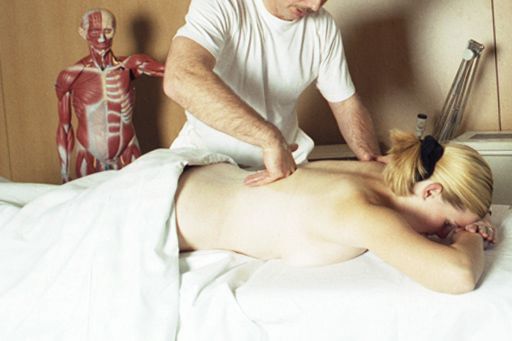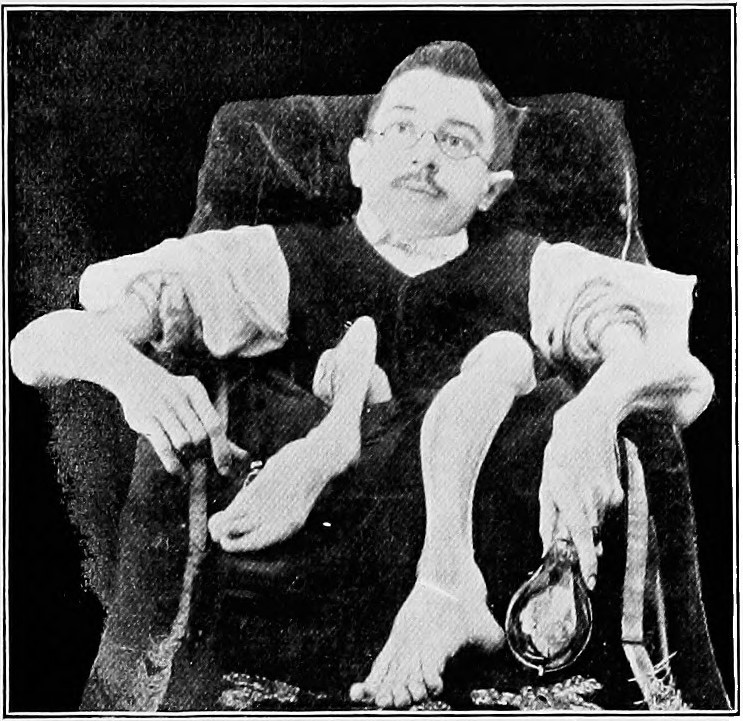|
Amyoplasia
Amyoplasia is a condition characterized by a generalized lack in the newborn of muscular development and growth, with contracture and deformity that affect at least two joints. It is the most common form of arthrogryposis. It is characterized by the four limbs being involved, and by the replacement of skeletal muscle by dense fibrous and adipose tissue. Studies involving amyoplasia have revealed similar findings of the muscle tissue due to various causes including that seen in sacral agenesis and amyotrophic lateral sclerosis. So amyoplasia may also include an intermediate common pathway, rather than the primary cause of the contractors. Signs and symptoms Amyoplasia results when a fetus is unable to move sufficiently in the womb. Mothers of children with the disorder often report that their baby was abnormally still during the pregnancy. The lack of movement in utero (also known as fetal akinesia) allows extra connective tissue to form around the joints and, therefore, the joints ... [...More Info...] [...Related Items...] OR: [Wikipedia] [Google] [Baidu] |
Arthrogryposis
Arthrogryposis (AMC) describes congenital joint contracture in two or more areas of the body. It derives its name from Greek, literally meaning 'curving of joints' (', 'joint'; ', late Latin form of late Greek ', 'hooking'). Children born with one or more joint contractures have abnormal fibrosis of the muscle tissue causing muscle shortening, and therefore are unable to perform active extension and flexion in the affected joint or joints. AMC has been divided into three groups: amyoplasia, distal arthrogryposis, and syndromic (is a syndrome or part of a syndrome). Amyoplasia is characterized by severe joint contractures and muscle weakness. Distal arthrogryposis mainly involves the hands and feet. Types of arthrogryposis with a primary neurological or muscle disease belong to the syndromic group. Signs and symptoms Often, every joint in a patient with arthrogryposis is affected; in 84% all limbs are involved, in 11% only the legs, and in 4% only the arms are involved. Every joint ... [...More Info...] [...Related Items...] OR: [Wikipedia] [Google] [Baidu] |
Occupational Therapy
Occupational therapy (OT), also known as ergotherapy, is a healthcare profession. Ergotherapy is derived from the Greek wiktionary:ergon, ergon which is allied to work, to act and to be active. Occupational therapy is based on the assumption that engaging in meaningful activities, also referred to as occupations, is a basic human need and that purposeful activity has a health-promoting and therapeutic effect. Occupational science the study of humans as 'doers' or 'occupational beings' was developed by inter-disciplinary scholars, including occupational therapists, in the 1980s. The World Federation of Occupational Therapists (WFOT) defines occupational therapy as ‘a client-centred health profession concerned with promoting health and wellbeing through occupation. The primary goal of occupational therapy is to enable people to participate in the activities of everyday life. Occupational therapists achieve this outcome by working with people and communities to enhance their abi ... [...More Info...] [...Related Items...] OR: [Wikipedia] [Google] [Baidu] |
Physical Therapy
Physical therapy (PT), also known as physiotherapy, is a healthcare profession, as well as the care provided by physical therapists who promote, maintain, or restore health through patient education, physical intervention, disease prevention, and health promotion. Physical therapist is the term used for such professionals in the United States, and physiotherapist is the term used in many other countries. The career has many specialties including musculoskeletal, orthopedics, cardiopulmonary, neurology, endocrinology, sports medicine, geriatrics, pediatrics, women's health, wound care and electromyography. PTs practice in many settings, both public and private. In addition to clinical practice, other aspects of physical therapy practice include research, education, consultation, and health administration. Physical therapy is provided as a primary care treatment or alongside, or in conjunction with, other medical services. In some jurisdictions, such as the United Kin ... [...More Info...] [...Related Items...] OR: [Wikipedia] [Google] [Baidu] |
Tendon Transfer
A tendon transfer is a surgical process in which the insertion (anatomy), insertion of a tendon is moved, but the origin (anatomy), origin remains in the same location. Tendon transfer involves redistribution of muscle power, not recreation. Tendons are transferred at the distal attachment from lesser to more important functions so that the overall function is improved. Tendon transfers provide a substitute which can be permanent or temporary, when muscle function is lost either due to nerve injuries or injuries to the muscle/tendon unit. Tendon transfers are also performed to correct the imbalanced muscle tone due to spasticity resulting from injuries to the central nervous system. Principles Preoperative evaluation of the patient is required to map out functional deficits, and determine which muscles are available for transfer. Time from injury, type of injury, and success of previous treatment should also be taken into account. Electrodiagnostic medicine, Electrodiagnostic stud ... [...More Info...] [...Related Items...] OR: [Wikipedia] [Google] [Baidu] |
Gastroschisis
Gastroschisis is a birth defect in which the baby's intestines extend outside of the abdomen through a hole next to the belly button. The size of the hole is variable, and other organs including the stomach and liver may also occur outside the baby's body. Complications may include feeding problems, prematurity, intestinal atresia, and intrauterine growth restriction. The cause is typically unknown. Rates are higher in babies born to mothers who smoke, drink alcohol, or are younger than 20 years old. Ultrasounds during pregnancy may make the diagnosis. Otherwise, diagnosis occurs at birth. It differs from omphalocele in that there is no covering membrane over the intestines. Treatment involves surgery. This typically occurs shortly after birth. In those with large defects, the exposed organs may be covered with a special material and slowly moved back into the abdomen. This condition affects about 4 per 10,000 newborns. Rates of the condition appear to be increasing. Sig ... [...More Info...] [...Related Items...] OR: [Wikipedia] [Google] [Baidu] |
Abdominal Wall Defect
Abdominal wall defects are a type of congenital defect that allows the stomach, the intestines, or other organs to protrude through an unusual opening that forms on the abdomen. During the development of the fetus, many unexpected changes occur inside the womb. Specifically, the stomach, intestines, or other organs begin to develop outside the fetus' abdomen through the abnormal hole in the abdomen and, as development progresses, the abdominal wall eventually encloses these organs. In some cases of defect either the umbilical opening is too oversized or has developed improperly which allows the organs to remain outside or to squeeze through the abdominal wall. There are two main types of abdominal wall defects that result due to the changes during development. They are omphalocele and gastroschisis. Gastroschisis develops when the abdominal wall does not completely close, and the organs are present outside of the infant's body. Omphalocele occurs when some of the organs protrude th ... [...More Info...] [...Related Items...] OR: [Wikipedia] [Google] [Baidu] |
Intestinal Atresia
Intestinal atresia is any congenital malformation of the structure of the intestine that causes bowel obstruction. The malformation can be a narrowing (stenosis), absence or malrotation of a portion of the intestine. These defects can either occur in the small or large intestine. Symptoms and signs The most prominent symptom of intestinal atresia is bilious vomiting soon after birth. This is most common in jejunal atresia. Other features include abdominal distension and failure to pass meconium. The distension is more generalised the further down the bowel the atresia is located and is thus most prominent with ileal atresia. Inability to pass stool is most common with duodenal or jejunal atresia; if stool is passed, it may be small, mucus-like and grey. Occasionally, there may be jaundice, which is most common in jejunal atresia. Abdominal tenderness or an abdominal mass are not generally seen as symptoms of intestinal atresia. Rather, abdominal tenderness is a symptom of the ... [...More Info...] [...Related Items...] OR: [Wikipedia] [Google] [Baidu] |
Club Feet
Clubfoot is a congenital or acquired defect where one or both feet are rotated inward and downward. Congenital clubfoot is the most common congenital malformation of the foot with an incidence of 1 per 1000 births. In approximately 50% of cases, clubfoot affects both feet, but it can present unilaterally causing one leg or foot to be shorter than the other. Most of the time, it is not associated with other problems. Without appropriate treatment, the foot deformity will persist and lead to pain and impaired ability to walk, which can have a dramatic impact on the quality of life. The exact cause is usually not identified. Both genetic and environmental factors are believed to be involved. There are two main types of congenital clubfoot: idiopathic (80% of cases) and secondary clubfoot (20% of cases). The idiopathic congenital clubfoot is a multifactorial condition that includes environmental, vascular, positional, and genetic factors. There appears to be hereditary component ... [...More Info...] [...Related Items...] OR: [Wikipedia] [Google] [Baidu] |
Neurogenic
In biology, the nervous system is the highly complex part of an animal that coordinates its actions and sensory information by transmitting signals to and from different parts of its body. The nervous system detects environmental changes that impact the body, then works in tandem with the endocrine system to respond to such events. Nervous tissue first arose in wormlike organisms about 550 to 600 million years ago. In vertebrates, it consists of two main parts, the central nervous system (CNS) and the peripheral nervous system (PNS). The CNS consists of the brain and spinal cord. The PNS consists mainly of nerves, which are enclosed bundles of the long fibers, or axons, that connect the CNS to every other part of the body. Nerves that transmit signals from the brain are called motor nerves (efferent), while those nerves that transmit information from the body to the CNS are called sensory nerves (afferent). The PNS is divided into two separate subsystems, the somatic and a ... [...More Info...] [...Related Items...] OR: [Wikipedia] [Google] [Baidu] |
Muscular Dystrophy
Muscular dystrophies (MD) are a genetically and clinically heterogeneous group of rare neuromuscular diseases that cause progressive weakness and breakdown of skeletal muscles over time. The disorders differ as to which muscles are primarily affected, the degree of weakness, how fast they worsen, and when symptoms begin. Some types are also associated with problems in other human organs, organs. Over 30 different disorders are classified as muscular dystrophies. Of those, Duchenne muscular dystrophy (DMD) accounts for approximately 50% of cases and affects males beginning around the age of four. Other relatively common muscular dystrophies include Becker muscular dystrophy, facioscapulohumeral muscular dystrophy, and myotonic dystrophy, whereas limb–girdle muscular dystrophy and congenital muscular dystrophy are themselves groups of several – usually extremely rare – genetic disorders. Muscular dystrophies are caused by mutations in genes, usually those involved in making ... [...More Info...] [...Related Items...] OR: [Wikipedia] [Google] [Baidu] |
Myogenic
The myogenic mechanism is how arteries and arterioles react to an increase or decrease of blood pressure to keep the blood flow constant within the blood vessel. Myogenic response refers to a contraction initiated by the myocyte itself instead of an outside occurrence or stimulus such as nerve innervation. Most often observed in (although not necessarily restricted to) smaller resistance arteries, this 'basal' myogenic tone may be useful in the regulation of organ blood flow and peripheral resistance, as it positions a vessel in a preconstricted state that allows other factors to induce additional constriction or dilation to increase or decrease blood flow. The smooth muscle of the blood vessels reacts to the stretching of the muscle by opening ion channels, which cause the muscle to depolarize, leading to muscle contraction. This significantly reduces the volume of blood able to pass through the lumen, which reduces blood flow through the blood vessel. Alternatively when the sm ... [...More Info...] [...Related Items...] OR: [Wikipedia] [Google] [Baidu] |







